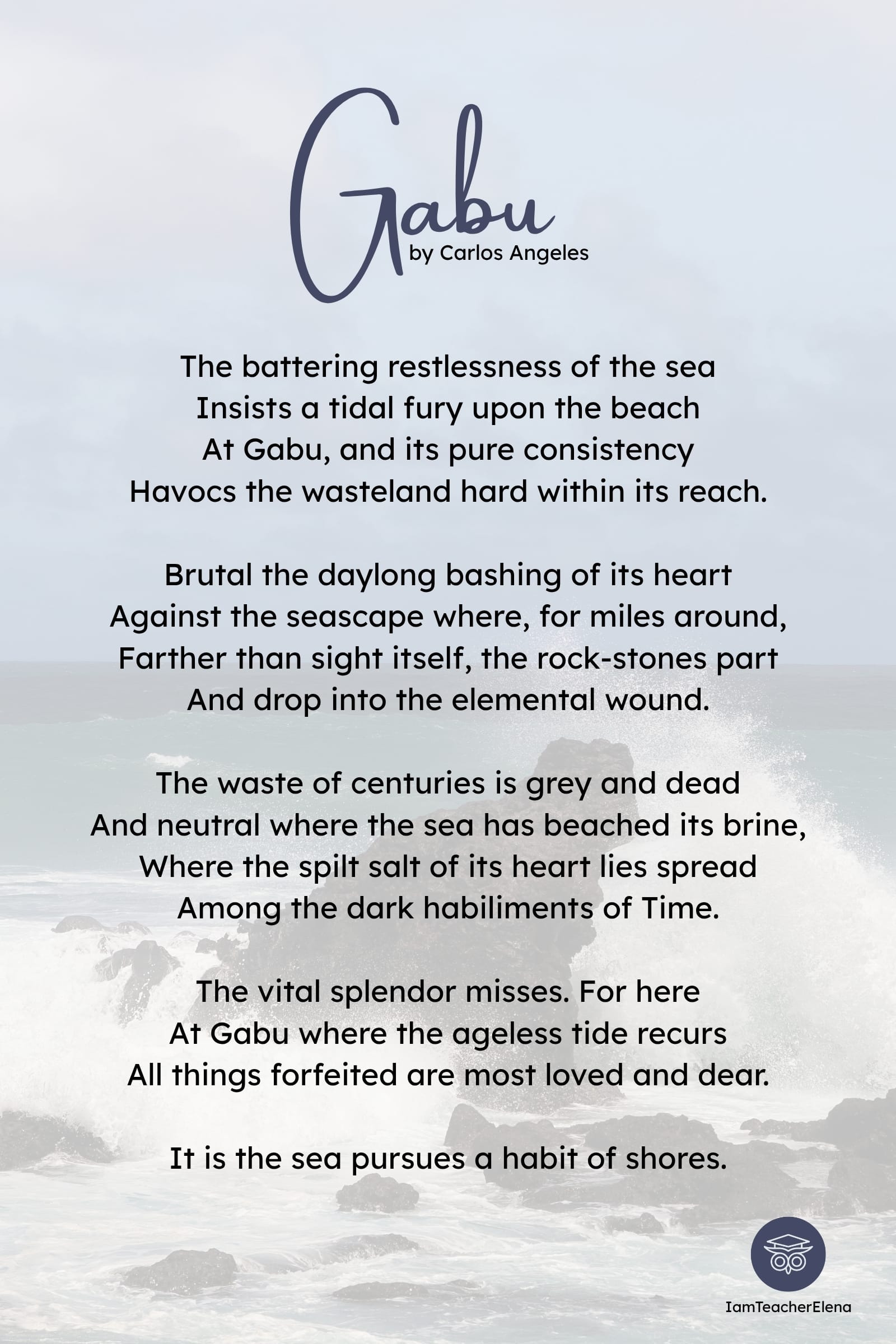Have you read Gabu by Carlos Angeles but are still wondering about the meaning behind it?
In this post, we’ll cover everything you need to know about the poem.
Who is Carlos A. Angeles?
- Born on May 25, 1921 in Tacloban City, Leyte
- Graduated from Rizal High in 1938
- Various universities in pre-med and pre-law
- One sem at Ateneo de Manila
- Two at UP in 1941 (member of the UP Writers’ Club)
- One quarter at Central Luzon Colleges
- Did not return to school after World War II
- 1950 to 1958
- Chief of the Philippine bureau of International News Service
- 1958 to 1980
- Guest of the US State Department on a Smith-Mundt leader grant
- Press assistant under the Garcia administration
- Public relations manager of PanAm Airlines
- Board of directors of International PEN, Philippine chapter
- A Stun of Jewels
- 1963
- 47 poems
- In 1964, when poetry was first considered in the Carlos Palanca Memorial Awards for Literature, received first prize
- Republic Cultural Heritage Award for Literature
- USA since 1978 with his family

Analysis

Genre: What is the genre of the poem?
- Philosophical (Existentialist)
- Lyric Poem
The poem involves the search for the true existence of the self. With this in mind, the poem can be defined as a journey of self-discovery.
Persona: Who is the one talking in the poem?
Here are possible personas in the poem:
- The persona in the poem is probably someone on a beach at Gabu, watching the rough sea, contemplating life.
- It could also be someone sitting on a beach at Gabu, watching the rough ocean waves. He has to confront his own mortality while he is sitting there and watching it all unfold. In life, we are constantly confronted with death and decay, even though we try our best to shield ourselves from it.
- Another possible persona is someone who lost a loved one because of the fury of the sea.
Theme: What does the poem tell us?
- Life can be restless like the sea; temporal, but desires permanence.
Life can be restless like the sea, and sometimes it seems that we are just drifting around. But there is beauty in the temporal as well; life should be lived to its fullest. Life should not merely be a waiting game but a living game. We may never reach permanence on this earth, but perhaps we can find a sense of fulfillment in these fleeting moments.
Setting: What is the setting referred to or described in the poem?
- A place in Ilocos Norte near the sea
- Often, when typhoons occur, places like this are affected greatly
- Tsunami
- Ex: typhoon Imbudo, July 2003
Meaning and Imagery: What is the meaning behind the poem?
Here’s a detailed analysis of the poem according to each stanza.
First Stanza:
The battering restlessness of the sea
Insists a tidal fury upon the beach
At Gabu, and its pure consistency
Havocs the wasteland hard within its reach.
What does the first stanza mean?
A quick look, we can say that the sea is restless and can be destructive.
Right away, we see that the sea is not calm—it is restless and powerful. It constantly pounds the shore with force, never stopping, never tiring.
- Sea = Life → The sea represents life itself—always moving, always changing.
- Battering restlessness = Impermanence → Just like life, the sea is unpredictable and often harsh.
- Havocs the wasteland = Destruction and change → The sea’s movement reshapes the shore, much like how life’s struggles shape us over time.
🔎 Guiding Thought: Have you ever felt like life was as relentless as the waves in this poem?
Second Stanza:
Brutal the daylong bashing of its heart
Against the seascape where, for miles around,
Farther than sight itself, the rock-stones part
And drop into the elemental wound.
What does the second stanza mean?
Here, you can tell that the turmoil of the sea is continuous and powerful.
The poet emphasizes the endless, powerful force of the sea. It never stops crashing against the land, much like how challenges in life seem to come one after another.
- Brutal bashing = Life’s chaos → Life is full of struggles, just as the sea never stops hitting the shore.
- Elemental wound = Depths of the sea → The sea, like life, has deep, unknown places—representing the mysteries and hardships we all face.
🔎 Guiding Thought: Can you relate to the idea that struggles in life feel continuous and overwhelming, much like the waves that never stop crashing?
Third Stanza:
The waste of centuries is grey and dead
And neutral where the sea has beached its brine,
Where the spilt salt of its heart lies spread
Among the dark habiliments of Time.
What does the third stanza mean?
The focus shifts to time—the sea has been there for centuries, shaping the land.
- Waste of centuries = The past → Time has passed, and with it, things have been lost and forgotten.
- Spilt salt = Bad luck or loss → Salt, often associated with tears or hardship, is spread across time.
- Dark habiliments of Time = The weight of history → Time has a way of burying things, just like the sea buries the past beneath the waves.
🔎 Guiding Thought: This stanza reminds us that nothing lasts forever. Can you think of things in your life that have changed over time?
Fourth Stanza:
The vital splendor misses. For here
At Gabu where the ageless tide recurs
All things forfeited are most loved and dear.
What does the fourth stanza mean?
This stanza brings out a bittersweet truth—sometimes, we only appreciate things once they are gone.
- Vital splendor misses = Something important is absent → The beauty of life seems to fade because everything changes.
- All things forfeited are most loved and dear → We often don’t realize the value of things—people, places, moments—until we lose them.
🔎 Guiding Thought: Have you ever taken something for granted, only to realize its importance after it was gone?
Fifth Stanza:
It is the sea pursues a habit of shores.
What does the fifth (or last) stanza mean?
The poem ends with a simple but powerful line.
- The sea keeps returning to the shore → Just as waves never stop crashing, life never stops moving forward.
- Life is always in motion, but we seek something permanent → Just as the sea always reaches for the shore, people long for stability, meaning, and even a sense of eternity.
Many believe this line could symbolize the afterlife or something beyond the struggles of this world:
- Shore = Afterlife → Just as the waves reach the shore, life eventually reaches an endpoint.
- The sea keeps moving, but the shore remains → Could this mean that despite life’s chaos, there is something stable and eternal waiting for us?
🔎 Guiding Thought: Do you think this final line suggests hope, or is it simply stating a fact about life’s continuous movement?
Figures of Speech: What are the figures of speech in the poem Gabu?
1. Metaphor
A metaphor is when we compare two things directly without using “like” or “as.” In Gabu, the sea is a metaphor for life itself.
Sea = life
Think about how the sea is constantly moving, changing, and sometimes even violent—just like life.
Life, much like the waves, can be unpredictable. It can be calm one moment and stormy the next, just as we experience joy and hardships throughout our journey.
This comparison makes the poem feel more profound and relatable.
2. Personification
Personification gives human qualities to non-human things, making them seem alive and active. In Gabu, the poet describes the sea as if it has emotions and intentions.
The vital splendor misses
the sea pursues
Here, the sea is described as “missing” something and as actively “pursuing” something else. Of course, the sea doesn’t actually have emotions or chase things the way people do, but by using personification, the poet makes the sea feel more alive and powerful—almost as if it has a mind of its own. This adds to the idea that nature, like life, is constantly in motion, never stopping for anyone.
3. Synecdoche
Synecdoche is when a part of something is used to represent the whole. In the poem, we see this in the line:
Brutal the daylong bashing of its heart
Here, the “heart” is used to refer to the entire sea. The sea doesn’t literally have a heart, but the poet uses this word to represent the beating, crashing motion of the waves, almost as if the ocean itself is a living being with a pulsing heart. This makes the sea feel even more powerful and relentless.
4. Paradox
A paradox is a statement that seems contradictory but actually holds a deeper truth. In Gabu, we find this paradox:
All things forfeited are most loved and dear
At first, this might sound confusing. How can something we lose be the thing we love the most? But if we think about it, this is often true in life. We don’t always appreciate something until it’s gone.
The poem suggests that we only realize the true value of things—whether it’s time, people, or even nature—when we lose them. This line gives a bittersweet tone to the poem, reminding us of the fleeting nature of life and beauty.
Other Related Questions About Gabu by Carlos Angeles
Who is the target audience of “Gabu”?
As a teacher, I like to remind my students that poetry is for everyone, but certain poems resonate more with specific groups of readers. Gabu speaks to people who have experienced change, loss, or the realization that nothing in life is permanent.
- Attitude: Reflective, contemplative, and perhaps even a bit nostalgic. Readers who enjoy pondering life’s deeper questions will likely appreciate Gabu the most.
- Skills: The ideal readers of Gabu would have a basic understanding of figurative language and be able to appreciate deeper meanings in poetry. However, even those new to poetry can connect with its strong imagery and emotions. You just need to close-read it.
- Values & Beliefs: The poem appeals to those who understand that life is constantly shifting, much like the waves of the sea. It may resonate with people who believe in the importance of cherishing what they have before it’s gone.
Why was the poem written? What does it hope to achieve?
Poets write to capture emotions and experiences in a way that makes readers think and feel. Gabu is no different. Carlos Angeles wrote this poem to illustrate how life—like the sea—is relentless, constantly moving, and often unforgiving.
- Life is unpredictable. The waves crash against the shore just as challenges and hardships come our way.
- Everything changes. The poem reminds us that nothing stays the same. The sea erodes the shore, just as time changes everything around us.
- Loss makes us appreciate what we had. The line “All things forfeited are most loved and dear” suggests that we often don’t realize how much we value something until it’s gone.
In short, the poem wants its readers to reflect on the impermanence of life and the importance of cherishing moments while they last.
What is the rhyme scheme of Gabu?
If you take a closer look at the way Gabu is written, you’ll notice a clear pattern in how the lines end. This is called a rhyme scheme, and in this poem, it follows an ABAB CDCD EFEF GHGH pattern.
Here’s a line-by-line look:
- ABAB (first stanza) → sea (A), beach (B), consistency (A), reach (B)
- CDCD (second stanza) → heart (C), around (D), part (C), wound (D)
- EFEF (third stanza) → dead (E), brine (F), spread (E), Time (F)
- GHGH (final stanza) → here (G), recurs (H), dear (G), shores (H)
This structured pattern adds rhythm to the poem, reinforcing the relentless movement of the sea—just like the never-ending waves that crash against the shore.
Overall Lesson
Gabu by Carlos Angeles tells us to always remember that our lives are fleeting and that the only constant thing in life is change.
Life can be rough, like the sea. But we can believe that if the sea can find stability once it meets the shore, we can find it, too.
What do you think about the poem? Have you ever felt like life was as restless as the sea? Let me know in the comments!
Reference List:
DIWA Senior High School Series: 21st Century Literature from the Philippines and the World
This was originally published on my previous website at Teacher Anele <iamteacheranele.wordpress.com>
If you’re looking for more resources about literature, then make sure to browse my page.




